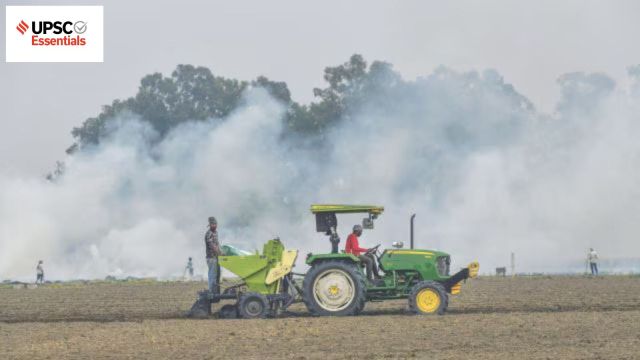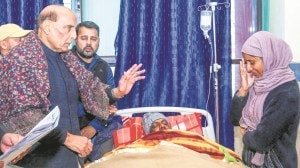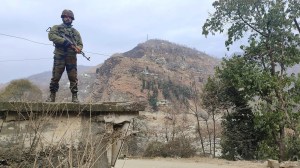- India
- International
UPSC Essentials | Mains answer practice — GS 3 (Week 44)
Are you preparing for UPSC CSE 2024? Here are questions from GS paper 3 for this week with essential points as the fodder for your answers. Do not miss points to ponder and answer in the comment box below. Try them out!
 Farmers work on field as others burn paddy stubble, on the outskirts of Jalandhar. Attempt question on crop residue management in today's answer writing practice. (PTI)
Farmers work on field as others burn paddy stubble, on the outskirts of Jalandhar. Attempt question on crop residue management in today's answer writing practice. (PTI)UPSC Essentials brings to you its initiative for the practice of Mains answer writing. It covers essential topics of static and dynamic parts of the UPSC Civil Services syllabus covered under various GS papers. This answer-writing practice is designed to help you as a value addition to your UPSC CSE Mains. Attempt today’s answer writing on questions related to topics of GS-3 to check your progress.
🚨 The Indian Express UPSC Essentials brings to you the March edition of its monthly magazine. Click Here to read. Share your views and suggestions in the comment box or at manas.srivastava@indianexpress.com🚨
QUESTION 1
What are the effects of crop residue burning? Discuss how baler machines are helpful in managing stubble.
QUESTION 2
Why southern India’s water supplies are rapidly running out? Discuss with examples.
General points on the structure of the answers
Introduction
— The introduction of the answer is essential and should be restricted to 3-5 lines. Remember, a one-liner is not a standard introduction.
— It may consist of basic information by giving some definitions from the trusted source and authentic facts.
Body

— It is the central part of the answer and one should understand the demand of the question to provide rich content.
— The answer must be preferably written as a mix of points and short paragraphs rather than using long paragraphs or just points.
— Using facts from authentic government sources makes your answer more comprehensive. Analysis is important based on the demand of the question, but do not over analyse.
— Underlining keywords gives you an edge over other candidates and enhances presentation of the answer.
— Using flowcharts/tree-diagram in the answers saves much time and boosts your score. However, it should be used logically and only where it is required.
Way forward/ conclusion
— The ending of the answer should be on a positive note and it should have a forward-looking approach. However, if you feel that an important problem must be highlighted, you may add it in your conclusion. Try not to repeat any point from body or introduction.
— You may use the findings of reports or surveys conducted at national and international levels, quotes etc. in your answers.
Self Evaluation
— It is the most important part of our Mains answer writing practice. UPSC Essentials will provide some guiding points or ideas as a thought process that will help you to evaluate your answers.
THOUGHT PROCESS
You may enrich your answers by some of the following points
QUESTION 1: What are the effects of crop residue burning? Discuss how baler machines are helpful in managing stubble.
Introduction:
— Harvesting diverse crops produces a vast number of residues, both on and off the farm. Cereals are the most residue-producing crops, followed by fibres, oilseeds, pulses, and sugarcane. Cereal crops (rice, wheat, maize, millets) contribute 70%, while rice crop alone contributes 34% to the crop residues.
— Crop residues serve various purposes, including animal bedding, livestock feed, soil mulching, bio-gas generation, bio-manure/compost, thatching for rural dwellings, mushroom cultivation, biomass energy production, fuel for residential use and industrial applications, etc.
Body:
You may incorporate some of the following points in the body of your answer:
Effect of crop residue burning
Loss of nutrients
— It is estimated that burning one tonne of rice straw results in a loss of 5.5 kg nitrogen, 2.3 kilogramme phosphorus, 25 kg potassium, and 1.2 kg sulphur, in addition to organic carbon. Generally, crop wastes from various crops comprise 80% nitrogen (N), 25% phosphorus (P), 50% sulphur (S), and 20% potassium.
Impact on soil properties
— Heat from burning residues elevates soil temperature causing death of beneficial soil organisms.
Emission of greenhouse and other gases
— Burning crop wastes can emit greenhouse gases (GHGs), as well as trace gases and aerosols such CH4, CO, N2O, and NOX and hydrocarbons.
Baler Machine
— Balers compress agricultural residue into manageable and transportable bales.
— Before using a baler machine, farmers cut the crop debris with a tractor-mounted cutter. After two days of drying, the stubble is raked into straight lines. A tractor-mounted baler machine then compresses the stubble into compact bales with netting.
— Baler machines offer an additional source of income, as the compacted straw can be sold to various industries for different purposes.
— In fields where balers are used, farmers can immediately plough the field and sow the next crop.
Conclusion:
— Approximately 2,000 baler machines are in use in Punjab and have been for the past ten years. 1,268 of these are heavily subsidised (between 50 and 80 percent) by the Crop Residue Management (CRM) programme of the Centre.
— Aside from burning, stubble can be used as animal feed, compost manure, roofing material for rural areas, a source of biomass energy, a mushroom growing medium, packing material, fuel, paper, bioethanol, and industrial output.
(Source: How baler machines help manage stubble by Anju Agnihotri Chaba, 5 yrs after Punjab launched residue management scheme, balers help it crack field-fire code by Anju Agnihotri Chaba, agriwelfare.gov.in)
Points to Ponder
Straw Management System
Happy Seeders
Crop Residue Management (CRM) scheme
Related Previous Year Questions
Each year a large amount of plant material, cellulose, is deposited on the surface of Planet Earth. What are the natural processes this cellulose undergoes before yielding carbon dioxide, water and other end products? (2022)
What are the key features of the National Clean Air Programme (NCAP) initiated by the government of India? (2020)
QUESTION 2: Why southern India’s water supplies are rapidly running out? Discuss with examples.
Introduction:
— Groundwater is an essential source of irrigation and domestic water supply in both rural and urban areas. However, the overexploitation of this important resource has resulted in its depletion.
— According to a recent report from the Central Water Commission (CWC), water levels in southern Indian state reservoirs are low compared to last year and compared to other regions of the country in 2023.
Body:
You may incorporate some of the following points in the body of your answer:
— The CWC monitors 42 reservoirs located in the southern states: Andhra Pradesh, Telangana, Karnataka, Kerala and Tamil Nadu. In September 2023, the water stocks stood at \48 per cent of the total storage capacity, which then dropped to 46 per cent of the total storage capacity.
— During normal monsoon years across the country, usable water reserves in southern India reach 91% of total storage capacity. Even though the country as a whole received normal rainfall in 2023 (820mm, 94% of the Long Period Average), the monsoon across the south peninsular was not particularly strong.
— There was a vast inter-seasonal rainfall variability recorded during the southwest monsoon this year. Rainfall records by the India Meteorological Department (IMD) showed that the south peninsular India received normal or above rainfall only during the July 26-August 3 period during the four-month season.
— During last year’s monsoon, Karnataka received rainfall that was 18 per cent below normal, the least since 2015. Even the post-monsoon period did not bring much rain to the state.
Examples:
Drinking water crisis in Bengaluru
— The shortage of water is not restricted to Bengaluru, and neither is it only a drinking water problem. The entire state of Karnataka, as also the adjoining areas of Telangana and Maharashtra, are facing water scarcity.
Irrigated farming
— The diminishing of water supplies has a significant influence on high-water-intensive paddy farming, which is mostly practiced in Andhra Pradesh and Tamil Nadu.
Conclusion:
— South India has a very different kind of aquifer system. It is very rocky. The aquifers don’t hold a lot of water. They empty out quickly, and they also get recharged pretty quickly.
— The Central Water Commission shows that Karnataka reservoirs are currently holding water at only 26 per cent of their full capacity, which is at least ten percentage points lower than what is expected at this time of the year.
(Source: What has caused the water crisis in Bengaluru, neighbouring areas by Amitabh Sinha, Why water reserves in southern India are fast depleting in 2023 by Anjali Marar)
Points to Ponder
Rate of depletion of groundwater in India
How is India addressing its water needs?
Water shortage in Bengaluru
Related Previous Year Questions
Drought has been recognized as a disaster in view of its spatial expanse, temporal duration, slow onset and lasting effects on vulnerable sections. With a focus on the September 2010 guidelines from the National Disaster Management Authority (NDMA), discuss the mechanisms for preparedness to deal with likely El Niño and La Niña fallouts in India. (2014)
Dam failures are always catastrophic, especially on the downstream side, resulting in a colossal loss of life and property. Analyze the various causes of dam failures. Give two examples of large dam failures. (2023)
Previous Mains Answer Practice
UPSC Essentials: Mains answer practice — GS 1 (Week 43)
UPSC Essentials: Mains answer practice — GS 1 (Week 42)
UPSC Essentials: Mains answer practice — GS 2 (Week 43)
UPSC Essentials: Mains answer practice — GS 2 (Week 42)
UPSC Essentials: Mains answer practice — GS 3 (Week 43)
UPSC Essentials: Mains answer practice — GS 3 (Week 42)
Subscribe to our UPSC newsletter and stay updated with the news cues from the past week.
Apr 05: Latest News
- 01
- 02
- 03
- 04
- 05





























